Doyle, Anne  ORCID: https://orcid.org/0000-0002-2776-3476
(2022)
Overview of alcohol and other drug use among children and young people in Ireland.
Drugnet Ireland,
Issue 82, Summer 2022,
pp. 1-4.
ORCID: https://orcid.org/0000-0002-2776-3476
(2022)
Overview of alcohol and other drug use among children and young people in Ireland.
Drugnet Ireland,
Issue 82, Summer 2022,
pp. 1-4.
| Preview | Title | Contact |
|---|---|---|
|
PDF (Drugnet Ireland 82)
661kB |
Background
This 2022 overview analyses prevalence, trends, and harmful consequences of alcohol and other drug use among children and young people aged 15–24 years in Ireland.1 The overview is a collation of published literature (both Irish and international), data from national information systems, and survey data specifically focusing on young people or where the survey or publication included young people. The overview also examined potential risk and protective factors that may influence substance use, along with responses to substance use and policies and legislation that govern alcohol and drug use in Ireland.
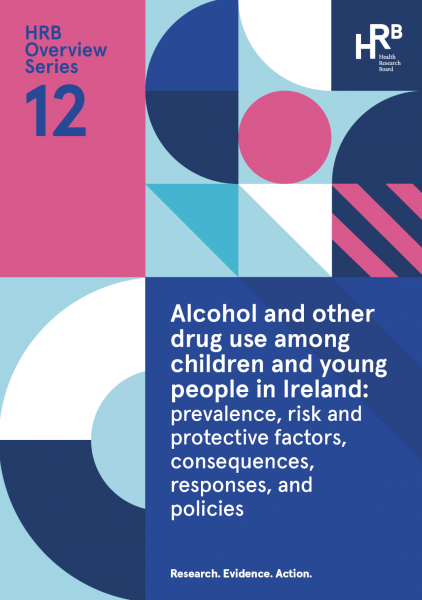
Key findings
Alcohol use
Alcohol is the most commonly used substance among young people in Ireland. The Public Health (Alcohol) Act 2018 acknowledges the issue of alcohol use, particularly among young people, and many of its components are specifically aimed at delaying initiation and reducing alcohol use. Survey data indicated a decrease in the number of young people aged 15–24 years who had used alcohol in their lifetime from 89% in 2002 to 74% in 2019 and the age of first alcohol use increased from 15.6 years to 16.6 years in the same period. Among a narrower age cohort (15–16 years), the decline in alcohol use was also obvious; however, it was less so among those aged 17 years.
Between 2002 and 2019, monthly heavy episodic drinking decreased from 74% to 56% among those aged 15–24 years, yet hazardous drinking was found to be commonplace for many (64%) and one in three young drinkers have an alcohol use disorder.
Parents or guardians were the most common source of alcohol for 16-year-old and 17-year-old schoolchildren and most drinking took place in their own home or a friend’s home. Adolescents reported most commonly drinking alcohol to enjoy parties or to make social gatherings more fun. However, of concern were those who reported drinking alcohol to help when they are feeling depressed or nervous, to forget about their problems, or to cheer up.
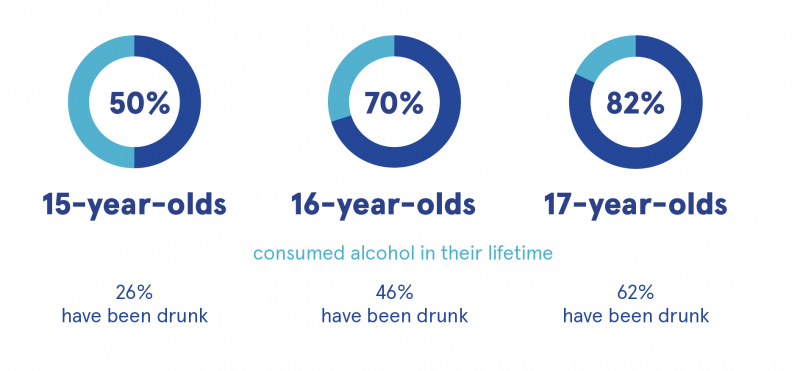
Drug use
Over one-quarter of young people aged 15–24 years reported using an illegal drug in their lifetime (27%), 19% reported use in the last year, and 11% reported use in the last month. Last-year use of any illegal drug among young people plateaued between the period 2014 to 2019, although when examined by sex, males showed a decrease in illegal drug use, whereas females showed an increase. More than two in five third-level students who were current drug users reported using two or more substances on the same occasion.
Cannabis remains the most commonly used illegal drug by young people: 23% reported lifetime use and 15% reported last-year use. A decrease in last-year cannabis use was observed from 16% in 2014 to 15% in 2019, although this decline was not reflected in the young female data, where an increase was shown. Lifetime cannabis use among 15–16-year-old schoolchildren was higher in Ireland (19%) than the average use across participating countries in the European Schools Project on Alcohol and Other Drugs (16%), and while many European countries have seen a decrease in lifetime use of cannabis since 2011, in Ireland its use has remained constant.
Cocaine use in the last year among young people increased from 3% in 2014 to 4.4% in 2019; although its use decreased among young males, from 5.1% to 4.2%, it increased among females (from 0.8% to 4.5%). Young people in Ireland were ranked second highest users of ecstasy and of cocaine in Europe.
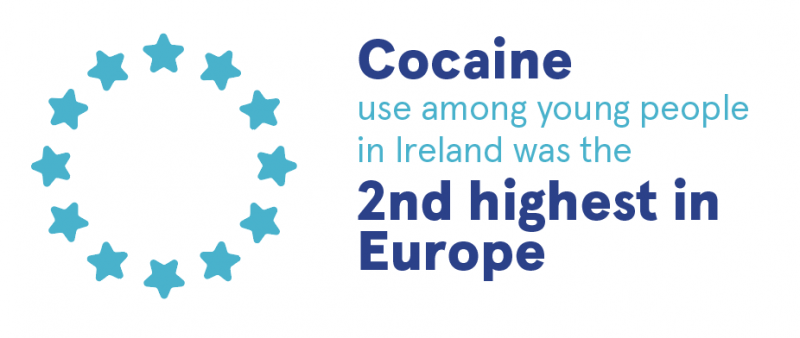
Use of magic mushrooms declined between 2002 and 2019 as has the use of solvents; however, the use of poppers increased. The prevalence of new psychoactive substances (NPS) use among young people decreased as a result of legislation introduced in 2010 and the resulting head shop closures; last-year use decreased from 9.7% in 2010 to 1.7% in 2019.
Risk and protective factors
There are a number of protective factors that may help to prevent and/or delay substance use and reduce the potential for harm when use does occur. There are also risk factors in young people’s lives that can contribute to early initiation or harmful use. Potential risk factors are early alcohol or other drug initiation; peer and/or parental substance use; parental provision of alcohol; certain personality traits; exposure to alcohol marketing; liberal parental attitudes to drinking and/or drunkenness; and parental or family conflict. Conversely, factors influencing young people to avoid or delay substance use include having supportive parents, effective parental monitoring, and positive school experiences, including good grades and good relationships with teachers.
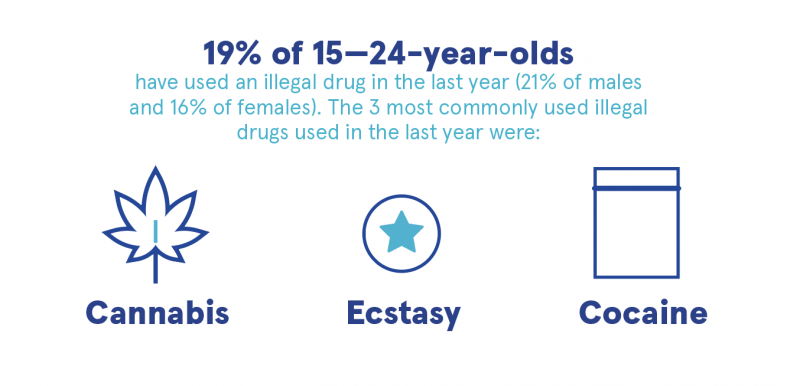
Consequences of alcohol and drug use
The harmful consequences of substance use are outlined in this overview, including the relationship between substance use and mental health. Adolescents classified as problem or hazardous drinkers were most likely to be in the severe category for depression and more likely to have engaged in deliberate self-harm or have attempted suicide. In almost three-quarters of suicide cases among young people, there was a history of alcohol and/or drug misuse. Cannabis users were six times more likely to report mental ill health compared with non-users.
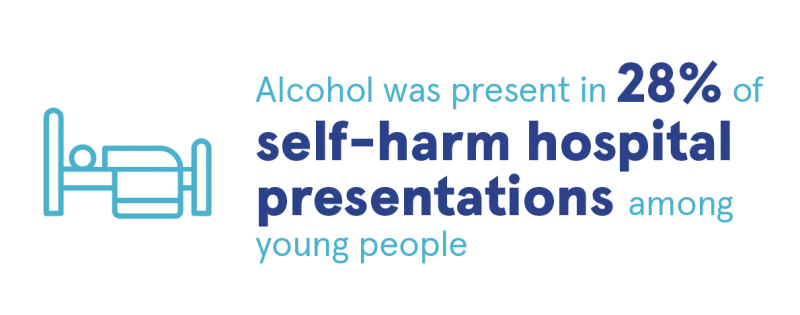
Alcohol-related hospitalisations among young people increased by 12% between 2015 and 2018, but decreased by 16% between 2018 and 2019, while drug-related discharges increased by 26% between 2015 and 2018 but decreased by 3.2% in 2019. Cannabis, followed by opioids and cocaine, accounted for the majority of drug-related hospitalisations, with cocaine-related hospitalisations increasing by 83% between 2015 and 2019.
The overview also examined Garda PULSE data and found that 14% of drink-driving arrests, 30% of drug-driving arrests, and 43% of controlled-drug-offences arrests were of young people aged 18-24 years. Data from the Road Safety Authority indicated that one-half (49%) of young driver fatalities during 2013–2017, with a toxicology result available, had a positive toxicology for alcohol.
Data from the National Drug-Related Deaths Index (NDRDI) indicated that 322 young people aged 15–24 years died died due to drug or alcohol poisoning during the period 2008–2017; there were 412 non-poisoning deaths due to trauma (deaths among people with a lifetime history of drug use/dependency, alcohol dependency, or where alcohol was implicated in the death) in the same period.
When examining Probation Services data, the majority of young people referred to its services had a history of drug and/or alcohol misuse (86%) and the link between their substance use and the crime committed was highlighted. Probation Officers commonly referred clients to appropriate services to address their alcohol and drug use.
Responses to alcohol and illegal drug use
Data from the National Drug Treatment Reporting System (NDTRS) indicated that during the period 2011–2020, some 8,608 cases of young people aged under 25 years received treatment due to their alcohol use and 27,569 for their drug use. The most common drugs for which treatment was received during that period were cannabis, opioids, and cocaine. Treatment for cocaine use increased substantially (171%) during the reporting period, while treatment for opiate use decreased.
Conclusion
Drinking behaviours are slowly changing with more young people delaying alcohol initiation or choosing not to drink at all. However, for many who do start drinking, a pattern of hazardous drinking emerges, often with harmful consequences. Although illegal drug use has plateaued, a change is evident in the increase in polydrug use and in use of stimulants, such as ecstasy and cocaine, along with an increase in the use of illegal drugs by young females.
The overview provides relevant and up-to-date information about the drug and alcohol situation among young people in Ireland, which is important for those who work with young people and for policymakers in order to respond effectively.
1 Doyle A, Sunday S, Galvin B and Mongan D (2022) Alcohol and other drug use among children and young people in Ireland: prevalence, risk and protective factors, consequences, responses, and policies. HRB Overview Series 12. Dublin: Health Research Board. https://www.drugsandalcohol.ie/36112/
A Substance use and dependence > Prevalence > Substance use behaviour
A Substance use and dependence > Substance related societal (social) problems
B Substances > Substances in general
B Substances > Alcohol
B Substances > New (novel) psychoactive substances > Other novel substances > Amyl nitrites (poppers)
J Health care, prevention, harm reduction and treatment > Harm reduction > Substance use harm reduction
L Social psychology and related concepts > Family > Family and kinship > Family and substance use > Substance related family problems
T Demographic characteristics > Child / children
T Demographic characteristics > Adolescent / youth (teenager / young person)
T Demographic characteristics > Young adult
VA Geographic area > Europe > Ireland
Repository Staff Only: item control page